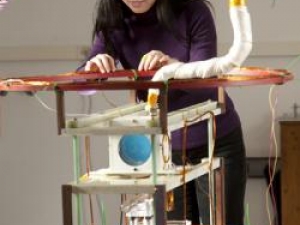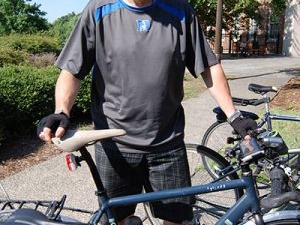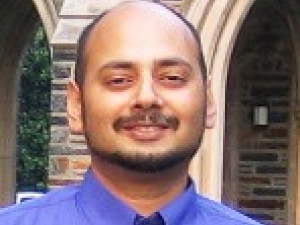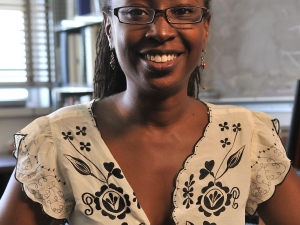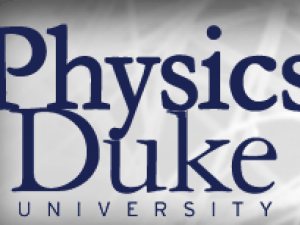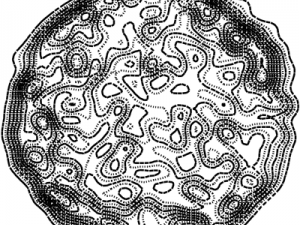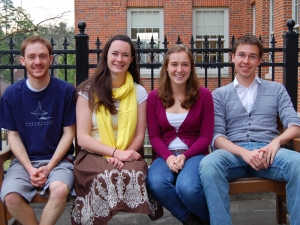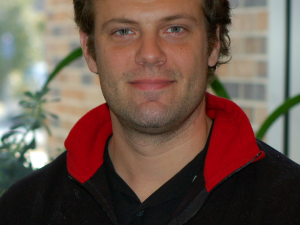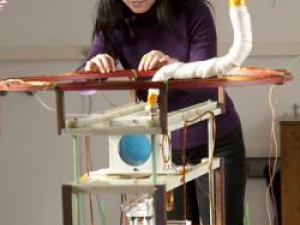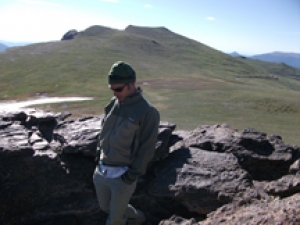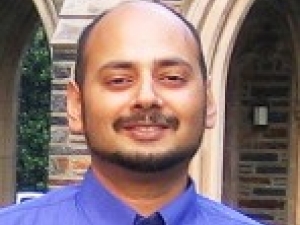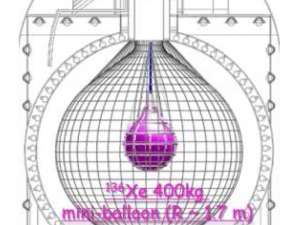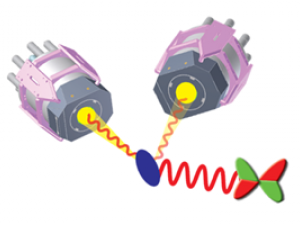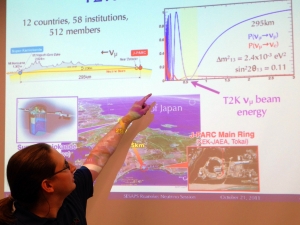Today at noon, Prof. Haiyan Gao will participate in a live webcast interview, for which viewers are invited to submit questions in advance or during the show. Send in questions by email, Twitter (#dukelive) or Facebook! Watch the webcast live here. Photo Credit: Megan Morr, Duke Photography read more about Today: Gao Will Participate in Live Webcast »
Professor and Chair Haiyan Gao was recently interviewed for an In the Spotlight feature on EurekAlert!'s website. Read the article "Brain drain (and gain) is an outdated notion for China" here. read more about Gao Featured on EurekAlert! Website »
Research conducted by the DARPA grant recently awarded to Prof. Nicolas Buchler is featured on the Duke Today website. Read "Unwinding Nature's Clocks" here. Read more about Buchler receiving the DARPA grant here. read more about Buchler Featured on Duke Today »
Understanding quantum critical behavior in strongly correlated fermion systems is an exciting contemporary topic of research, that arises in condensed matter, nuclear and particle physics. Although Monte Carlo calculations offer a first-principles approach to the problem, accurate computations near a fermionic quantum critical point has been missing so far due to difficulties in fermionic Monte Carlo methods. In a recent article that was accepted for publication in Physical Review Letters, Prof. Shailesh… read more about Accurate Computations Near a Fermionic Quantum Critical Point »
The Durham Board of County Commissioners has appointed Duke Physics Administrative Manager Randy Best to the Bicycle and Pedestrian Advisory Commission as the representative for Duke University. He will begin participation in the next meeting, March 20. Congratulations, Randy! read more about Best Appointed to BPAC »
A special scientific seminar on the W Mass measurement from CDF took place February 23 at Fermi Lab. The speaker was Prof. Ashutosh Kotwal. Read the press release here and the article "Higgs Boson Gets New Mass Limit" in Duke Today here. Congratulations to Ashutosh, the team and other CDF colleagues at Duke! read more about New Results from CDF »
Prof. Ayana Arce has been selected as a recipient of the 2012 Career Enhancement Fellowship for Junior Faculty by the Woodrow Wilson National Fellowship Foundation. read more about Arce Receives Career Enhancement Fellowship »
Duke University Physics is represented by 42 papers at the APS March Meeting this year. Using the APS's "affiliation" search function, here is a webpage with a list of all of our papers. You can see that a wide variety of work from several departments at Duke is represented. Thank you to Prof. Harold Baranger for compiling this list. read more about Duke Physics at the APS March Meeting »
Graduate student Hung-Ming Tsai's figure in his PhD publication "Entropy production and equilibration in Yang-Mills quantum mechanics" was chosen by Physical Review E as "Kaleidoscope" figure. View the image here and read the paper here. read more about Tsai's Figure Chosen as Kaleidoscope Figure »
What do first-year graduate students like about Duke Physics? “It’s a strong department—strong in many different areas,” says Meg Shea, who earned her BS at Yale. “Here there are lots of options.” Shea likes the structured way in which the department introduces new graduate students to all the options. In a series of seminars over the course of the year, professors from each research group give talks about their work. The seminars include dinner, and the casual atmosphere allows students to get to know… read more about The First Year in the Graduate Program at Duke Physics »
Prof. Nicolas Buchler has received funding from the Defense Advanced Research Projects Agency (DARPA), entitled “Biochronicity: Time, Evolution, Networks.” The goal is to automate the discovery of periodic processes in Biology at the cellular level. It is an interdisciplinary project involving multiple investigators with theoretical and experimental expertise in circadian clocks, cell cycle, metabolism, and development. John Harer (Duke) is the lead PI. The other team members are: Steve Haase and… read more about Buchler Receives DARPA Funding »
In a new Physical Review Letters paper (J. Huang et al., PRL108, 052001 (2012), [link], co-authored by members in Prof. Haiyan Gao's Medium Energy Physics Group, new measurements of novel spin phenomena provide the first experimental indication of a partial alignment of quark spin along the direction of motion of a neutron spinning perpendicularly to its direction of motion. Such an alignment, known as transversal helicity, can only be observed if the quarks undergo orbital motion inside… read more about Spinning Quarks Yield Clues to Orbital Motion »
Prof. Daniel Gauthier, postdoc Hugo Calvalcante and graduate student Seth Cohen's paper "Subwavelength Position Sensing Using Nonlinear Feedback and Wave Chaos" was recently published in Physics Review Letters. The article was selected as an editor's suggestion and Cohen was interviewed by Duke Today. The story is featured on the Duke Research Blog. You can read "Chaos puts a path on nanoparticles" here or download it from Physorg.com here. read more about Optics Group Featured in PRL, Cohen Interviewed »
Prof. Patrick Charbonneau and collaborators have taken another crack at the glass problem. Read the paper "Geometrical Frustration and Static Correlations in a Simple Glass Former" on Physical Review Letters website here. read more about Charbonneau Published in PRL »
January 25, 2012 was the first science fair of the spring semester for the physics outreach group. Physics graduate student Kristine Callan, undergraduates Lauren Musso (physics), Hunter Douglas (engineering), and Chad Liu (engineering) accompanied Derek Leadbetter to host Duke's physics demo tables at North Chatham Elementary's Science Night. The evening was a huge success, attended by hundreds of elementary school students. Our volunteer student team received many… read more about First Science Fair of the Year Success for Outreach Group »
Browse through our collection of stories about alumni of both our undergraduate and graduate programs at Duke Physics. Keep in touch! Email us with your news. Sheila Brown Bailey, undergrad 1967, is a photovoltaic researcher at NASA’s Glenn Research Center. Joshua Bienfang, undergrad 1994, is a physicist at the National Institute for Standards and Technology. Roger Byrd, PhD 1978, designs satellite instruments and software to detect nuclear testing, Sandia National… read more about Alumni Profile Collection »
Prof. Calvin Howell will chair the committee to search for a new dean of the Graduate School at Duke. Read the article "Howell to Chair Committee Searching for New Graduate School Dean" on Duke Today's website here. This new chair will succeed the late Jo Rae Wright. Read a tribute to Wright in the Chronicle of Higher Education here. read more about Howell to Chair Search Committee for New Grad School Dean »
Prof. Matthew Hastings had a paper published in Science this month. You can read "Universal Signatures of Fractionalized Quantum Critical Points" online here. Hastings was also featured in a Duke Today articles "Electron's Negativity Cut in Half by Supercomputer" as well as the front page of The Chronicle. read more about Hastings' Paper Featured Widely »
Prof. Ashutosh Kotwal's PhD thesis on "Proton and deuteron structure functions in muon scattering at 470-GeV'' is now a "famous paper" according to citation count. Read it here. read more about Kotwal's Thesis Famous »
An undergraduate team of three students, Zongjin Qian, Peter Zhu, and Josh Loyal won a silver medal in the "University Physics Competition," which is described here. read more about Undergrads Receive Silver Medal »
Prof. Robert Behringer was featured in a December 14, 2011 article in Duke Today titled "Stress Causes Clogs in Coffee and Coal." You can read it online here. If you have a subscription to Nature or are on campus you can see the paper here and here. read more about Prof. Behringer Featured in Nature and Duke Today »
Research done by the Theoretical Nuclear and Particle Physics group is currently being featured on the homepage of RENCI, the Rennaissance Computing Institute at UNC. The story contains some nice videos which have been created in collaboration with visualization specialists at UNC. Read the article "Modeling the perfect fluid" here. 1/13/12 Update: A version of this news article has appeared on the International Science Grid This Week (ISGTW) site. You can read it here. read more about Theoretical Physics Research on RENCI Site »
The electron neutrino appearance results from the Tokai-to-Kamioka experiment reported in June have been selected as one of the top 10 breakthroughs in physics by Physics World magazine. Read the story here. read more about T2K Oscillation Results Chosen in the Top 10 Physics Breakthroughs of 2011 »
Every year the graduate school uses various types of endowments to give out fellowships to outstanding graduate students. These fellowships are both merit and need based. This year four graduate students from the physics department were nominated by the Director of Graduate Studies (DGS) based on requests from the faculty and students. Three students (Meg Shea, Kyle Kalutkawiecz and Chris Varghese) were nominated for summer fellowships that provides funds to cover tuition… read more about Physics Graduate Students Win Duke Fellowships »
Submitted by Prof. Werner Tornow After discovering reactor neutrino oscillations, determining the heat produced by radioactive decays in the interior of the Earth, determining the extraterrestrial high-energy anti-neutrino flux on Earth, and studying solar neutrinos with the KamLAND detector, on October 12, 2011 a subgroup of the original Japanese-US KamLAND collaboration commenced its search for the zero-neutrino double-beta decay of 136Xe. For this purpose, a 3.4 m diameter nylon balloon filled with about 400 kg… read more about KamLAND-Zen Started Zero-Neutrino Double-Beta Decay Search »
TUNL's instrumentation development work done in collaboration with the detector group at Jefferson Laboratory was recently featured in the DOE Pulse. The DOE Pulse is an online newsletter that highlights science and technology at DOE National Laboratories. You can read the story online here. read more about Duke-JLab Plant Instrumentation R&D featured on DOE Pulse »
Alumni Seth Henshaw ('10) and his Duke colleagues in TUNL Profs. Henry Weller and Mohammad Ahmed's recent Physics Review Letter 107, 222501 (2011): A New Method for Precise Determination of the Isovector Quadrupole Resonances in Nuclei (Henshaw, Ahmed, Feldman, Nathan, Weller) has been highlighted by the APS. Read the synopsis "Ringing Nuclear Resonances" here. One more demonstration of the power of the beams at HIGS! read more about New HIGS Result Spotlighted by APS »
Nasser Demir earned his Ph.D in 2010 working with Prof. Steffen A. Bass. During the 2010-2011 academic year he was an Instructor in the Physics Department involved with teaching Physics 54 and Physics 62. Dr. Demir has recently officially been appointed as Assistant Professor in the Physics Department at Kuwait University, where he has been teaching since September 2011. He shall join the Theoretical Physics group at Kuwait University as the third nuclear theorist. See his Kuwait University… read more about Nasser Demir Appointed as Assistant Professor of Physics at Kuwait University »
The Southeastern Section of the American Physical Society (SESAPS) annual meeting (SESAPS 2011) was held Oct. 19-22 in Roanoke, VA. The meeting was hosted by Virginia Tech and over 295 people attended. Prof. Roxanne Springer was the chair of the program committee as part of her duties as Chair-Elect of SESAPS. The conference was held at an historic hotel, now called the Hotel Roanoke and Conference Center, which is listed in the National Register of Historic Places as a favorite 19th and early 20th… read more about Duke Physics at SESAPS 2011 »
Prof. Stefano Curtarolo and Shidong Wang, a postdoc in Curtarolo's lab, have a paper in the journal Physics Review X about a new materials "cookbook" they have compiled. The cookbook contains information to help scientists and engineers combine elements to create thermoelectric devices. "We have calculated the thermoelectric properties of more than 2,500 compounds and have calculated all their energy potentials in order to come up with the best candidates for combining them in the most efficient ways, "… read more about Prof. Curtarolo and Postdoc Compiled "Cookbook" »

